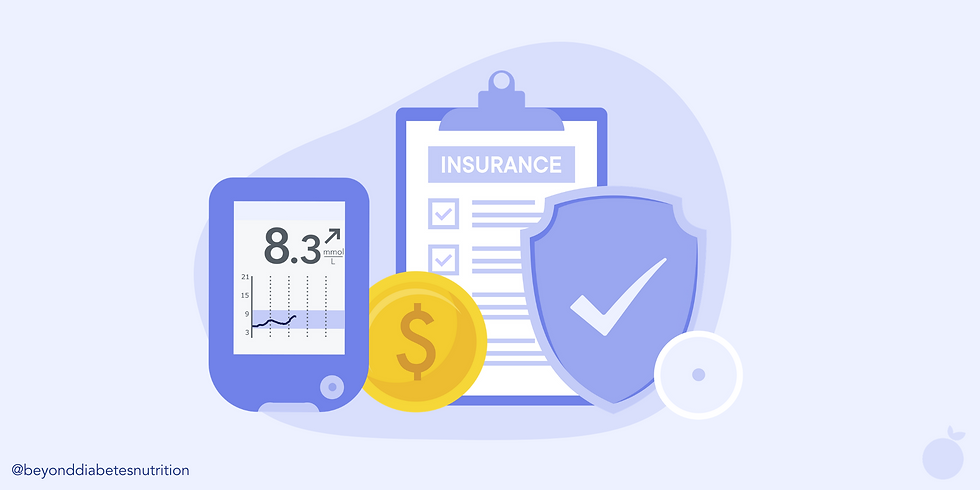When is the Best Time to Check Blood Sugar?
- Lucy Zhang, RD, CDE
- Nov 2, 2021
- 4 min read
Updated: Jan 31, 2024
Has your healthcare team encouraged more frequent blood glucose (sugar) monitoring? Are you someone who only checks blood sugar first thing in the morning? Whether you are new to testing blood sugar or you have your routine down pat, read on to see if you are getting the most out of your blood sugar testing.

Why do I need to check blood sugar?
You may be thinking “my doctor orders blood work to monitor my blood sugar every few months, why do I need to check blood sugar at home?”
While your healthcare team is able to monitor overall blood sugar control via labs for HbA1c, and can check random blood glucose (RBG) or fasting blood glucose (FBG) on the day of the blood work, these labs don’t provide much information on how much your blood sugar fluctuates across the day. At-home monitoring of blood sugar is a great way to get feedback on how your food and activity routines impact blood sugar and is crucial information for guiding your healthcare team’s treatment decisions.
To paint a full picture of what blood sugar looks like across the day, there really isn’t a short cut - it takes testing at different times across the day!
How often do I need to check my blood sugar?
It depends!
If you are newly diagnosed with diabetes, I often recommend testing 1 to 2 times per day initially. This is to learn where YOUR blood sugar sits across the day. In addition, if you are in the process of making lifestyle changes or your physician has prescribed medications or insulin to help with blood sugar management - it allows you to see the impact of these changes on blood sugar. Staggered or paired testing patterns would both be great options.
If you have been managing diabetes for a fair amount of time, your overall blood sugar control is stable and within target, aim to test 2 to 3 times per week. This is because blood sugar trends can change over time, maintaining a routine of checking a few times per week is a good way to keep an eye on your own trends in between blood work (this may be every 3 months or even every 6 months).
If you take any oral medications associated with a risk of low blood sugar, it’s a good idea to test blood sugar at least once daily at different times across the day. These medications include: gliclazide (Diamicron® and Diamicron MR®), glyburide (DiaBeta®), glimepiride (Amaryl®), and repaglinide (GlucoNorm®). A staggered pattern of testing would be a good option.
If you take insulin once daily (e.g. basal insulin), it’s a good idea to test blood sugar each morning before eating (fasting blood sugar) - this helps to determine if the insulin dose you are using remains appropriate. The general rule of thumb is "check your blood sugar level at least as often as you take insulin". In addition, it would be a good idea to check blood sugar at staggered times across the day on a regular basis to determine what blood sugar looks like at different times. Remember, basal insulin is working in the background throughout the day.
If you take basal insulin AND mealtime insulin, test blood sugar before each dose of insulin.
If you use a Freestyle Libre system for blood sugar monitoring, scan at least every 8 hours. Each scan of the Libre sensor records the previous 8 hours of glucose data. That means if you are able to scan at least every 8 hours apart, you are able to capture what blood sugar looks like across 24 hours of the day.
On top of your usual testing pattern, consider additional testing if:
You are feeling unwell - check to rule out low blood sugar!
You are sick - your blood sugar may fluctuate more than your usual patterns
You are more active than usual
Your treatment regimen has been adjusted (e.g. medication changes, insulin titration).
You have been drinking alcohol

When is the best time to check blood sugar?
There are two patterns of testing I often recommend to get the most out of your blood sugar testing.
Pattern 1: Staggered Testing
This involves testing once per day at different times each day. Over time, you are able to capture where blood sugar sits across the day.
Pattern 2: Paired Testing
This involves testing before and two hours after each meal. It’s a great way to learn how different foods impact blood sugar! Curious if a meat and potatoes meal impacts your blood sugar differently than pasta or curry or casserole? Test it out!

While your glucometer will save your blood sugar data for a long time, it’s a good idea to record blood sugar readings. This could be either on paper, in a logbook or notebook, on an Excel document, or on a phone app. This allows you to more easily identify if there are any trends to your blood sugar.
Need a little help interpreting your blood sugar data? Your physician or certified diabetes educator can help!
Got a blood sugar testing question on your mind? Comment below with your questions!
Advertisement




Comments